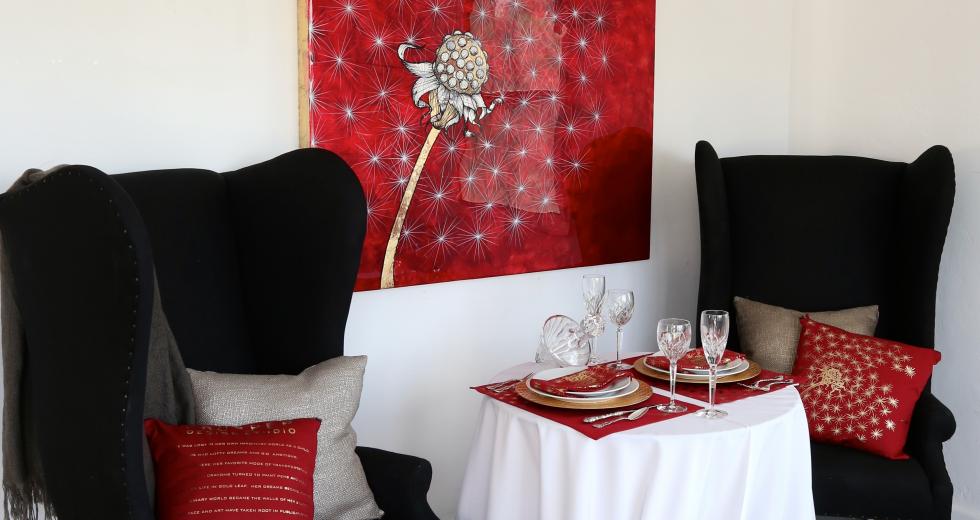Maren Conrad’s paintings can be found in some of Sacramento’s chicest homes and flashiest office buildings, even in our gallery at City Hall. But despite these trappings of success, Conrad found herself constantly under the gun. Each piece sold meant returning to the studio to begin the next in an exhausting cycle of create, sell and repeat. This process left little time for new projects, and she began to brainstorm a more sustainable income stream — mailbox money.
“Mailbox money is residual income,” says Conrad. “For visual artists, licensing, products or prints can provide checks in the mail.”
Hence the birth of Prosper Design Studio, a home decor line that uses Conrad’s original artwork as inspiration for table runners, placemats, pillows and the like – and will provide an additional income source while Conrad nurtures those creative juices.
Whether you are a starving or established artist, we could all use a little mailbox money. Here’s how to begin the process:
1. Choose a product that means something to you and your artistic brand: In addition to being a visual artist, Conrad also attended culinary school. Throwing a dinner party is second nature to her, and a big part of the experience is making the table an exciting canvas in its own right. Creating an art-based product is an extension of your brand so make sure to base the concept on something true to you. No one wants to see the Martha Stewart S&M line. Leave that to Rihanna.
The Grey Area partners with artists to create and sell functional art pieces such as apparel, furniture and other products and is a great place to start exploring options.
2. Find a partner to execute your vision: This might be the most crucial step, as most artists don’t want to spend their time researching retail trends and calling up China to negotiate textile pricing. You’ll need someone else to ensure your manufacturing workers aren’t six-month old endangered pandas. Don’t fret if you don’t have a personal relationship with someone who has the proper skillset. Elance, Guru and Crowdspring are all great resources for getting connected to potential teammates.
3. Source your materials: Where the hell do I find organic cotton? Who manufactures pop-up books? Anyone have a good Icelandic barn wood connection? The answers to these questions are probably not as hard as you think. There are many resources to connect you to the right supplier to help make your dream line a reality.
As young moms who care about sustainability, Conrad and her business partner, Elizabeth Wood, found a supplier in India who uses organic materials and pays a living wage to his workers. In this day of facebook-educated ethicists and rabid mommy-blogs, it is crucial to have transparency about your product.
Maintain your integrity, even if it means paying a little more. Alibaba is a terrific clearinghouse for almost any production/supplier category imaginable. Globalsources is another. Make sure to do your homework before locking in with a supplier.
4. Find your customer base: The best audience for an offshoot might be your current customers, or it might be a different group entirely. In either case, it is important to keep two things in mind:
Let your current supporters know about your new venture. Mom was putting your charcoal nudes on the refrigerator when you were still in grade school, so maybe she’ll be interested in purchasing a sock puppet.
If she’s not, find your new audience! If you’re knitting custom quilts, head to Nana’s nursing home. If you’re making Twerk shorts, head to Miley Cyrus or The Castro. If you’re launching a line of custom gourds, please stick to whatever you were doing before and start again.
Wherever your new market is, it is important to go where your customers are – whether it’s social media, an online sales platform or cross-promotion with an already-established brand. Whatever your strategy, make a website. Nowadays babies can use tablets. Don’t be that guy flashing the GoDaddy logo when we look up your brand.
There are e-commerce websites for artists as well as online-services that let you build your own brand’s site, but there are also a host of online marketplaces (Etsy, WePay, Shopify and Storefront to name a few) to sell your goods or even connect to vacant retail for a pop-up.
5. JFDI: No matter what your idea, the most important step is always the first one – just go for it. Sometimes you won’t know what resources you’ll need until you take that initial leap. Maybe the partner you need will see you striving for greatness and come to your aid.
If you’re serious about getting started, set aside your doubts and make an investment in yourself. Trust that your resourcefulness and determination will be enough to get you started. If you were crazy enough to make it as a professional artist, you already have what you need in the cojones department. So get out there and carpe that diem.
Sick of missing out? Sign up for our weekly newsletter highlighting our most popular content!
Recommended For You

What’s Eating Tim Collom?
A success in art and realty, Tim Collom still can’t relax
“Something isn’t quite right with Tim Collom. On the outside, Collom is doing far better than most of us. In the past year, he has been featured on KCRA-TV and HGTV speaking about real estate and in the pages of The Sacramento Bee and Sacramento Magazine showcasing his paintings.

Start Me Up
Local residents make product dreams a reality
Salon owner Carol Milani had never invented anything before, but she needed a way to keep her strong and fearless Bengal cat from escaping the yard.

Go Time
Hey Sacramento, let’s stop talking and get something done.
You may have recently noticed some random references to JFDI. Maybe it was in a tweet or a sticker on the back of a cell phone. The initials stand for Just F*cking Do It. It isn’t a new movement or an acronym from a New York Times Best Seller. It represents an attitude, a mindset and — most importantly — an unwavering willingness to act.

Pricing the Past
Collector Brian Witherell on the gambles and gains of antiques
Juxtaposed against the crisp, modern lines of Brian Witherell’s home in Alkali Flat sits a trove of ancient treasures, premier antiquities cherry picked from his company’s massive antique collection.




Comments
Very interesting and informative. Great article!
Love the concept of providing insights and resources. The world is your oyster! Congratulations on a terrific start.